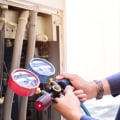Due to physical demands, a long run in HVAC can cause wear and tear on the body, especially on the knees, back and shoulders. While weightlifting techniques and proper ergonomic practices help, you may want to consider the havoc this profession can wreak on your body over time. The disadvantages of being an AC Repair near West Ashley SC technician include the physical nature of the job, long working hours, and the possibility of hazardous working conditions. The installation and maintenance of air conditioning and heating systems near West Ashley SC can be physically demanding, as HVAC technicians often have to lift heavy equipment and crawl into tight spaces. In addition, many HVAC technicians work long hours, especially during peak summer and winter months.
Finally, some HVAC technicians may be exposed to hazardous materials and must take safety precautions to protect themselves. According to the Bureau of Labor Statistics, HVAC technicians have one of the highest injury rates of all professions. The first step in reducing that number is to know which hazards pose the greatest threat. Here are 10 common HVAC safety hazards you should know about.
Electric shocks are some of the most significant hazards to air conditioning safety. Heating and air conditioning systems often use high-voltage equipment, so exposed live cables and similar electrocution risks pose a serious threat. Injuries resulting from these risks cause approximately 1000 deaths a year and represent 5% of admissions to burn rooms. HVAC workers are also frequently encountered with hazardous chemicals.
Refrigerants and fuels can emit toxic fumes, and some cleaners and solvents can cause burns or irritation if they come in contact with the skin. Some systems may also include pressurized gases, which pose a risk of fire and explosion. Asbestos is another common hazard to the safety of air conditioning systems. Many buildings built before the 1970s contain asbestos in their ducts, insulation, paint and floors.
Workers in heating, ventilation and air conditioning systems can inhale asbestos if these materials fray, which can lead to lung cancer. Field technicians should inspect all workplaces for signs of asbestos, especially in older homes. If they think there may be asbestos, they should wear disposable protective outer clothing, gloves and respirators. After completing work, employees should dispose of or disinfect this PPE and wash their hands to minimize exposure.
Asbestos is the most significant respiratory hazard faced by HVAC workers, but it's not the only one. They can also encounter hazardous fumes from paints, carbon monoxide from furnaces, and other airborne contaminants. While HVAC systems that emit dangerous levels of these toxins may be illegal in some areas, there is no federal HVAC code, so jobs in some states they may pose more dangers. As with any job involving large equipment, HVAC installation and repair also presents mechanical risks.
Sharp metal edges can cause lacerations and moving parts can pinch workers or snag their clothing. In some cases, employees may also use power tools with unique mechanical hazards. HVAC employees should always be aware of their environment, use lots of light and minimize noise to detect mechanical hazards. Personal protective equipment, such as cut-resistant gloves and protective footwear, will also help. Workers should inspect power tools before using them and follow OEM guidelines for safe use.
Extreme heat and cold are other common hazards to air conditioning safety. Heating equipment can get hot and the coolant can cause freezing hazards, especially if it's not working properly. Working in tight, confined spaces amplifies these risks. You must have JavaScript enabled to enjoy a limited number of items for the next 30 days. The integration of NFPA 70E, a standard for electrical safety in the workplace, and NFPA 70B, a standard for the maintenance of electrical equipment, is key to establishing an electrical safety program.
If you're deciding if a career in HVAC is right for you, be sure to consider all the good, bad and ugly parts of what it means to be a HVAC technician HVAC.


